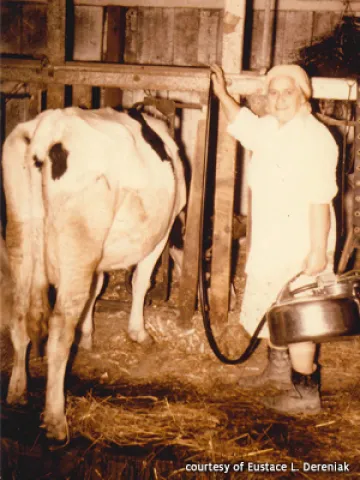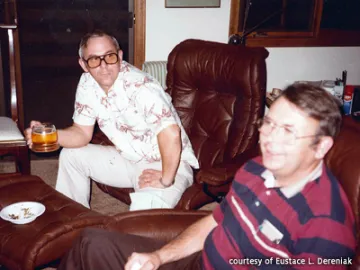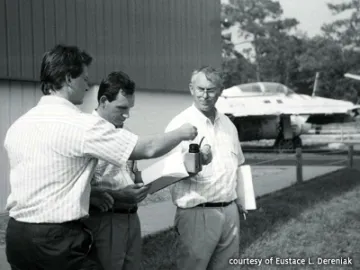Etendue: Eustace L. Dereniak

Welcome to Etendue, featuring interesting and accomplished individuals known for their leadership and contributions both with their careers and the College of Optical Sciences, in their own words. (For a similar view on the college’s best and brightest – our students – please check out Another Wavelength among our Students in the Spotlight.)
This month, we hear from OSC Professor Emeritus Eustace L. Dereniak, Ph.D. 1976.
Where are you from?
I was born in the small town of Standish, Michigan (population ~500), and lived there with my parents and two sisters until I left for college. We owned a family farm that consisted mostly of dairy cows and some chickens and pigs. My interest in optics began as a young boy while sorting young chicks into male and female categories. I wished — in vain — for a way to see into an egg to determine the sex of the chicken before investing time and effort incubating the egg for three weeks, since only the female chicks were allowed to live. (My sister pointed out this was due to the fact that girls were good and boys, bad). For my science project at the one-room Jarvis Center schoolhouse, my goal was to determine which eggs would produce roosters or hens. I tried Uncle John Dziuban’s theory that pointed-shaped eggs would become roosters. However, that did not prove successful.

Mom milking cows.
Farming as a career did not interest me. I disliked milking cows seven days a week, morning and night. I dreamed of the chance to go to college. I was never good at sports, so an athletic scholarship was out of the question. In fact, in those days, the process of determining the batter-up in baseball was to toss a bat to one of the players, whereupon each player would do a “hand over hand” to thef top of the bat to determine who was next. I could not even catch the bat when it was thrown to me!
So when the opportunity arose to attend college, I grabbed it, and subsequently enrolled at Michigan Technological University. After earning my B.S. in electrical engineering, I went on to the University of Michigan to pursue an M.S. in electrical engineering, and eventually received a Ph.D. from the University of Arizona.
While at the University of Michigan, I worked on infrared signatures of Russian reentry vehicles taken from airborne radiometers in the Pacific Ocean; meanwhile, bartending at night to help pay my expenses. Both jobs required much data analysis! I worked in the infrared Willow run lab where I met Bill Wolfe, a department head. I had no way of knowing that our paths would cross again in Tucson. In fact, Bill co-wrote the "Handbook of Military Infrared Technology," published in 1965.
Who influenced your career in optics?
After receiving my M.S. degree, I was employed for several years in the aerospace industry, at Raytheon in Boston and North American Aviation (NAA) in Los Angeles. It was at NAA that I met Jerry DeBell, who would change the course of my life and set me on the path to becoming a professor of optics. By the late 1960’s, I was working for Jerry, whose son, Mike DeBell, was attending OSC at the University of Arizona (his other twin son, Gary DeBell, was at University of Rochester). In those days the aerospace industry was struggling.

Polishing glass.
We were about to accomplish the “man on the moon” project, and engineers were abundant. I was building the analog pre-amplifiers for a cryogenically cooled (liquid neon) advance infrared seeker, which did not function due to blurred images. This problem triggered bickering between electrical and optical engineers as to whose hardware was to blame. Jerry, who was the project engineer, talked me into pursuing optics at the UA to further understand this dilemma. He was quite familiar with the UA’s outstanding optics program, via his son Mike.
The original idea was for me to attend OSC’s M.S. program and then return to NAA to work on the seeker. However, while I was pursuing this education, several events occurred that would change the course of my plans. NAA found the root of the problem with the infrared seeker, i.e., that the focal point shift was due to cryogenic cooling of the metal optics.
Since the aerospace business was beginning to downsize, my wife, Barbara, and I made the pivotal decision to stay in Tucson while I pursued a Ph.D. It is important to note here, that all the wonderful things came about from that decision is a true testament to Barbara’s unwavering support for me and her level-headed thinking. She and our daughters, Teresa and Andreana, were my constants. They waited many late nights for my arrival home from work and travel - and made every student that I would drag home for holiday meals feel like family.

Barbara and I enjoying my retirement celebration.
Describe your career in optics.
The OSC, now in its fifth decade, became home base for my optics career. Due to my infrared background, my mentor, Bill Wolfe, originally got me involved with thermography for the detection of breast cancer. This was the subject of my dissertation, clearly a major change from IR seekers. While studying at the UA, I also landed a job at Ball Aerospace, working on infrared weather satellites. I worked there for two years while completing my degree. I had two children by then, so I needed an influx of funds to support my new family! After completing my doctorate in 1976, I was hired as a professor by Peter Franken, and later on, by the grace of Bob Shannon, I received tenure.
Throughout my years as a professor, I worked in some unusual places, but never had an office in the Meinel building. Initially, my offices and lab were housed at the Jewish temple at Fifth Street and Campbell Avenue. In those days, the football practice field was located on the south side of Fifth Street, so players needed to cross Fifth Street, which was one-way after 4:00 p.m., through rush-hour traffic. In full uniform with helmets and sun in their eyes, it was difficult for the players to see west. Following a traffic accident involving two players, the practice field was moved to the northwest corner, and my labs were bulldozed to make way for the new fields. I was moved to McKale Center in 1988, and the Optical Detection Lab remained there for 25 years until my retirement in 2014.
Over the years, the research conducted in my lab has contributed to medicine, astronomy, military and defense hardware, to name a few. Projects have included intelligence-gathering aircraft, camouflage systems, and snapshot imaging spectrometers that detect missile launches/intercepts. My extensive study of infrared detectors and their application to optical systems was the main driving force of my career. This experience led to many applications in optical engineering, in particular the development of snapshot imaging spectrometers, which have entertained me for the past 20 years. This device was originally developed by one of my graduate students, Mike Descour.

Hans Roehrig helping me with my dissertation.
I was honored to receive several distinguished awards during my career, including Michigan Technological University’s Outstanding Alumni Award (1999), an award for distinction in undergraduate teaching from OSC (2006), the Ester Hoffman Beller Medal from the Optical Society of America for outstanding contributions to science and engineering education (2010), and the University of Arizona’s College of Optical Sciences Alumnus of the Year award (2013).
During my career, I mentored a combined total of 65 master's and doctoral students, many of whom have become lifelong friends and colleagues. I have also published nearly 100 papers and five books, chaired and participated in countless conferences and received two patents. While on sabbatical in 2009, I worked as a Visiting Professor at the U.S. Military Academy, West Point, and was honored to receive the U.S. Army’s Commander’s Award for Public Service for my extensive work with the U.S. Military.
I am Fellow in both the Optical Society of America and SPIE (The International Society for Optics and Photonics). In 2012, I served as President of SPIE, which currently has about 17,000 members worldwide. I am the only UA alumnus to have held this prestigious position.
How do you stay involved in the College?
I retired from OSC in 2014, but have remained active at the college while a few of my students—from A to Z; Riley Aumiller in 2013, to Walter Zachael in spring 2016—finish their degrees. And I am quite proud that my family, Barbara, Andreana, Teresa and I were joined with good friends, Elias and Claudia Martinez, to establish the Eustace Dereniak Family and Friends Undergraduate Scholarship in Optical Engineering. I am also grateful for the countless number of former students and friends who have, and continue to generously support, this scholarship. [Editor’s Note: To make a gift, please contact Kaye Rowan at rowan@optics.arizona.edu].
In my private life, my main emphasis is coordinating affairs with my rental properties and spending time on the family farm in Michigan.
Share your best OSC experience.
I would have to say that my best experiences during my years at OSC involved serving as President of SPIE and as a Professor, working with and mentoring highly motivated, intelligent students. I have many fond memories of my students that are a pleasure to reflect back on.
Although not my best experience, I must digress to a particularly memorable and funny event that occurred years ago. I had a contract to build a spectrometer that was located in a concealed location at the back of a RV mobile home, and I had great fun going to air shows with this contraption to obtain infrared signatures of aircraft. The RV was later commandeered by DoD (Department of Defense) personal and was in the process of traveling to some military installation, when it became disabled on the expressway from engine or transmission problems.

Meeting on the IR Signature of F-16s.
A local towing company took it to their facility, and the DoD asked if we could arrange to have it repaired in order to maintain a low profile. I sent Dave Perry, my graduate student, to take care of the instrument and ensure its safety. The invoice that was issued for the repairs was something like $7,000-10,000! I managed to get a cashier’s check for this amount, thanks to Sandra Singer, OSC’s director of finance and operations, and Federal Expressed it to Dave. However, he later called with the unfortunate news that Mr. Allen, from the repair shop, would only accept cash.
We argued for a couple of days whether a cashier’s check qualified as cash. Dave said that Mr. Allen would not capitulate – in fact, had removed a $20 bill from his billfold to demonstrate what he considered cash. Meanwhile, Mr. Allen was holding the RV, containing the DoD’s very sensitive spectrometer, hostage. We finally resorted to using Western Union to send cash in $500 increments (they would not do larger amounts). The additional costs involved with these transactions drove the OSC accounting department crazy! I’ll never forget this experience!
Name some neat facts about you.
- I have published three textbooks in optics, one of which I co-authored with my daughter, Teresa.
- My grandfather served in the Austrian-Hungary Army prior to World War I. I believe he was a captain of the cavalry. My family still has a photo of him in full army uniform, standing beside his horse and holding a sword.
